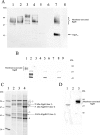The RgpB C-terminal domain has a role in attachment of RgpB to the outer membrane and belongs to a novel C-terminal-domain family found in Porphyromonas gingivalis
- PMID: 16923905
- PMCID: PMC1595369
- DOI: 10.1128/JB.00731-06
The RgpB C-terminal domain has a role in attachment of RgpB to the outer membrane and belongs to a novel C-terminal-domain family found in Porphyromonas gingivalis
Abstract
Porphyromonas gingivalis produces outer membrane-attached proteins that include the virulence-associated proteinases RgpA and RgpB (Arg-gingipains) and Kgp (Lys-gingipain). We analyzed the P. gingivalis outer membrane proteome and identified numerous proteins with C-terminal domains similar in sequence to those of RgpB, RgpA, and Kgp, indicating that these domains may have a common function. Using RgpB as a model to investigate the role of the C-terminal domain, we expressed RgpB as a full-length zymogen (recombinant RgpB [rRgpB]), with a catalytic Cys244Ala mutation [rRgpB(C244A)], or with the C-terminal 72 amino acids deleted (rRgpB435) in an Arg-gingipain P. gingivalis mutant (YH522AB) and an Arg- and Lys-gingipain mutant (YH522KAB). rRgpB was catalytically active and located predominantly attached to the outer membrane of both background strains. rRgpB(C244A) was inactive and outer membrane attached, with a typical attachment profile for both background strains according to sodium dodecyl sulfate-polyacrylamide gel electrophoresis, but in YH522KAB, the prodomain was not removed. Thus, in vivo, RgpB export and membrane attachment are independent of the proteolytic activity of RgpA, RgpB, or Kgp. However, for maturation involving proteolytic processing of RgpB, the proteolytic activity of RgpB, RgpA, or Kgp is required. The C-terminally-truncated rRgpB435 was not attached to the outer membrane and was located as largely inactive, discrete 71-kDa and 48-kDa isoforms in the culture supernatant and the periplasm. These results suggest that the C-terminal domain is essential for outer membrane attachment and may be involved in a coordinated process of export and attachment to the cell surface.
Figures


Similar articles
-
Role of RgpA, RgpB, and Kgp proteinases in virulence of Porphyromonas gingivalis W50 in a murine lesion model.Infect Immun. 2001 Dec;69(12):7527-34. doi: 10.1128/IAI.69.12.7527-7534.2001. Infect Immun. 2001. PMID: 11705929 Free PMC article.
-
Porphyromonas gingivalis gingipains: the molecular teeth of a microbial vampire.Curr Protein Pept Sci. 2003 Dec;4(6):409-26. doi: 10.2174/1389203033487009. Curr Protein Pept Sci. 2003. PMID: 14683427 Review.
-
Major outer membrane proteins and proteolytic processing of RgpA and Kgp of Porphyromonas gingivalis W50.Biochem J. 2002 Apr 1;363(Pt 1):105-15. doi: 10.1042/0264-6021:3630105. Biochem J. 2002. PMID: 11903053 Free PMC article.
-
Expression of Arg-Gingipain RgpB is required for correct glycosylation and stability of monomeric Arg-gingipain RgpA from Porphyromonas gingivalis W50.Infect Immun. 2005 Aug;73(8):4864-78. doi: 10.1128/IAI.73.8.4864-4878.2005. Infect Immun. 2005. PMID: 16041000 Free PMC article.
-
Gingipains, the major cysteine proteinases and virulence factors of Porphyromonas gingivalis: structure, function and assembly of multidomain protein complexes.Curr Protein Pept Sci. 2003 Dec;4(6):397-407. doi: 10.2174/1389203033487036. Curr Protein Pept Sci. 2003. PMID: 14683426 Review.
Cited by
-
A Riemerella anatipestifer Metallophosphoesterase That Displays Phosphatase Activity and Is Associated with Virulence.Appl Environ Microbiol. 2021 May 11;87(11):e00086-21. doi: 10.1128/AEM.00086-21. Print 2021 May 11. Appl Environ Microbiol. 2021. PMID: 33741629 Free PMC article.
-
The Carboxy-Terminal Region of Flavobacterium johnsoniae SprB Facilitates Its Secretion by the Type IX Secretion System and Propulsion by the Gliding Motility Machinery.J Bacteriol. 2019 Sep 6;201(19):e00218-19. doi: 10.1128/JB.00218-19. Print 2019 Oct 1. J Bacteriol. 2019. PMID: 31262839 Free PMC article.
-
Response of Porphyromonas gingivalis to heme limitation in continuous culture.J Bacteriol. 2009 Feb;191(3):1044-55. doi: 10.1128/JB.01270-08. Epub 2008 Nov 21. J Bacteriol. 2009. PMID: 19028886 Free PMC article.
-
Flavobacterium johnsoniae chitinase ChiA is required for chitin utilization and is secreted by the type IX secretion system.J Bacteriol. 2014 Mar;196(5):961-70. doi: 10.1128/JB.01170-13. Epub 2013 Dec 20. J Bacteriol. 2014. PMID: 24363341 Free PMC article.
-
Dipeptidyl-peptidases: Key enzymes producing entry forms of extracellular proteins in asaccharolytic periodontopathic bacterium Porphyromonas gingivalis.Mol Oral Microbiol. 2021 Apr;36(2):145-156. doi: 10.1111/omi.12317. Epub 2020 Oct 12. Mol Oral Microbiol. 2021. PMID: 33006264 Free PMC article. Review.
References
-
- Abaibou, H., Q. Ma, G. J. Olango, J. Potempa, J. Travis, and H. M. Fletcher. 2000. Unaltered expression of the major protease genes in a non-virulent recA-defective mutant of Porphyromonas gingivalis W83. Oral Microbiol. Immunol. 15:40-47. - PubMed
-
- Abe, N., A. Baba, R. Takii, K. Nakayama, A. Kamaguchi, Y. Shibata, Y. Abiko, K. Okamoto, T. Kadowaki, and K. Yamamoto. 2004. Roles of Arg- and Lys-gingipains in coaggregation of Porphyromonas gingivalis: identification of its responsible molecules in translation products of rgpA, kgp, and hagA genes. Biol. Chem. 385:1041-1047. - PubMed
-
- Aduse-Opoku, J., N. N. Davies, A. Gallagher, A. Hashim, H. E. A. Evans, M. Rangarajan, J. M. Slaney, and M. A. Curtis. 2000. Generation of Lys-gingipain protease activity in Porphyromonas gingivalis W50 is independent of Arg-gingipain protease activities. Microbiology 146:1933-1940. - PubMed
Publication types
MeSH terms
Substances
LinkOut - more resources
Full Text Sources
Other Literature Sources
Molecular Biology Databases

